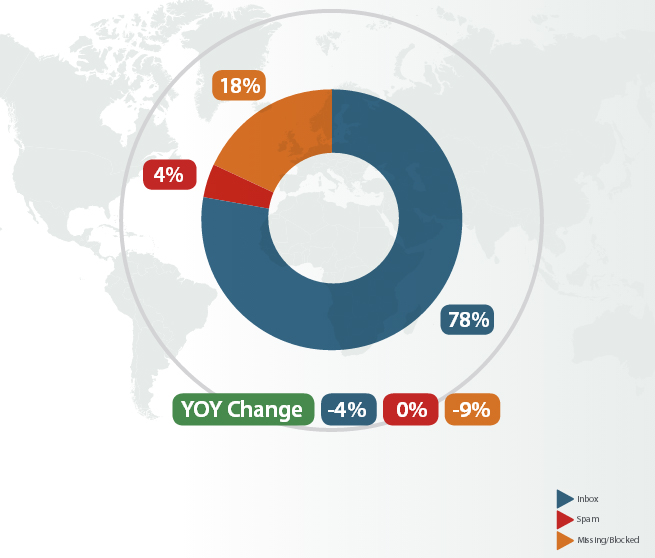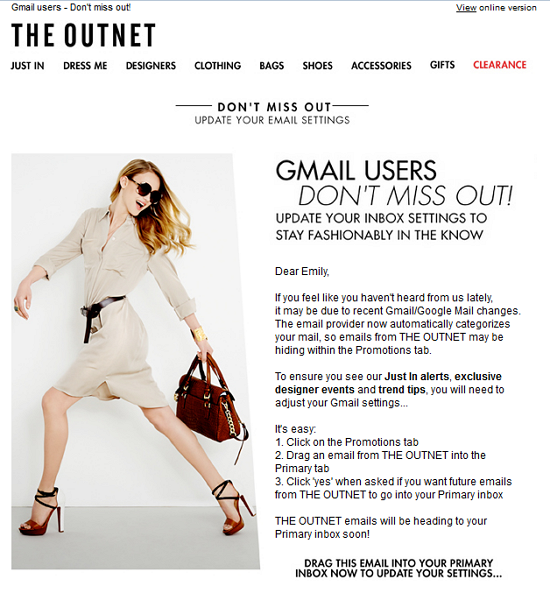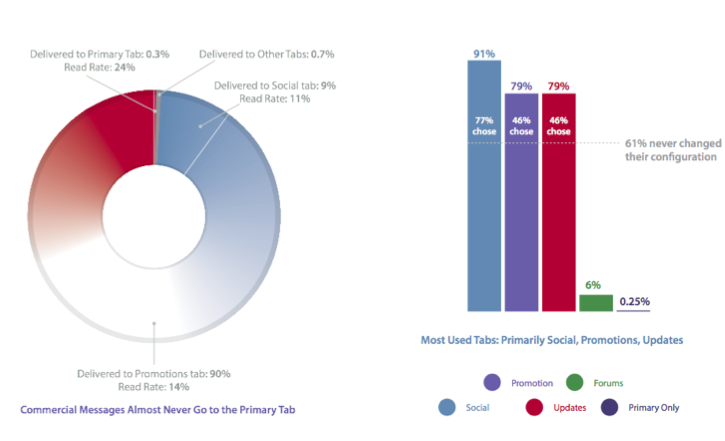According to ReturnPath’s 2013 email benchmark survey – 22% of opt-in emails aren’t reaching subscribers’ inboxes. And while that number is down from the 28% of the previous year – it still demonstrates that nearly a quarter of messages are missing the mark.

Email deliverability is improving, but only slightly
Despite advances in email marketing technology, spam trapping and opt-in communications, improving these numbers for yourself (essentially, your email reputation) is fairly simple and fundamental. Still, it’s all too easy to forget (or outright ignore) the basics.
First, let’s take a look at how emails are filtered. Understanding this will give you an inside look at reasons why your message could go missing.
Email Filters
Many email programs use simple filters to sort messages before they ever land in your inbox. You’ve likely set some of these up yourself – mail from domain “fakerolexwatchexample.com†automatically gets shuttled to the circular file, for example.
But your internet provider also tries to lend a hand in filtering. Oftentimes, ISPs will subscribe to a number of spam-detecting and filtering services, which in turn helps to free up their bandwidth and keeps junk traffic from bottlenecking in their networks. These services rely on domains and URLs being noted as spam by their subscribers, and thus blacklisted.
False-Positive Spam
Sometimes, your email address can be falsely marked as spam – particularly if your email message contains certain spam trigger words that have the unfortunate side effect of blacklisting your message before it ever goes through.
Here are few common trigger words:
- Buy
- Buy direct
- Order
- Cheap
- Cash
- $$$
- F r e e
- Save up to
- Success
- Wife
- Medium
- Avoid
- Friend
- Hello
- Dear
For a long list of spam trigger words, take a look at this Hubspot article.
Gmail’s Tabbed Inbox
Gmail’s newly-released tabbed inbox is in a class all its own when it comes to message filtering. Essentially, Gmail has taken it upon itself to automatically sort your messages into convenient “buckets†— Primary messages are from people you know and trust – friends, family and colleagues. Social messages are notifications from your social networks, and promotions are emails such as coupons, deals and offers (even if you’ve already subscribed to and whitelisted them).

Gmail’s introduction to the tabbed inbox
What’s more, a sponsored ad can appear at the top of your inbox and look precisely like a message sent on behalf of Google to clue you in to something you might like. It has its own sender, description and subject line – just like an actual email would.

A clever example of a Gmail ad
Currently, Gmail ads only appear in the promotional tab, so it’s in Google’s best interest to encourage users to click there. Fortunately, users are quickly learning that if they want access to the email deals they opted in to receive, they’d better pay attention to the Promotions tab.
A study by Returnpath has already been done to determine the deliverability and read rates of messages that are sent to the different tabs:
90% of commercial messages go to the Promotions tab – by the Primary tab is by far the most read
How to Gain Entry to the Ultra-Exclusive Primary Tab
The primary tab is where the biggest chunk of the reading takes place – and marketers are keen to get their emails into this ultra-exclusive favorites club. Here’s one tactic that a fashion site is using by sending out an email blast specifically targeting Gmail users:

When you drag an email into the primary inbox, you automatically whitelist the sender so that future messages from them will also be put in the Primary tab. Therefore, it’s in every marketer’s best interest to give their subscribers instruction on how to perform this one-time drag-and-drop.
Trigger Words that Get You in the Inbox
Just like trigger words can get your email mistakenly labeled as spam, so too can trigger words increase your odds of landing on the primary tab or inbox. In the case of Gmail, certain trigger words can also automatically land you in the Promotions tab – words like coupon, alert, direct message and receipt. Which words were most likely to make it past the digital gatekeeper?
Financial-sounding words like statement, reply and attachment. SMS led the pack though, with a staggering 51% of messages featuring it as part of the subject line getting a free pass:

Financial terms like statement and attachment get priority over other terms
What Email Marketers Need to Know
The bottom line is that, as senders, we need to keep our pulse on the kind of content our readers like and appreciate. The more our messages are tailored to their needs, the more likely they are to give us that coveted whitelisting.
With that being said, however, consumers will still mark a message as spam even if they originally opted in to receive it. For many users, marking a message as spam doesn’t so much say “I don’t know who this sender isâ€, but “this offer doesn’t fit me.†ReturnPath’s survey also found that subscribers were more likely to tag an email as spam rather than unsubscribe (even if the unsubscribe link was noticeable).
Beyond those things, here are a few more best practices to keep in mind:
- Make sure your list is spotlessly clean. No purchased email lists, no matter how fresh they promise to be. Survey your list and segment users accordingly to keep them in the loop with helpful messages that they’ll be more likely to read, click and interact with.
- On that note, many email providers will gauge how “whitelistable†you are as a sender, based on how the user interacts with your message. If they hit Delete as soon as it loads, your sender score will drop, whereas if they reply, forward, scroll or click, your score will increase.
- If you’ve been falsely blacklisted, it’s a good idea to set up a monitored email address – such as abuse@yourdomain.com so that spam-filtering organizations and major ISPs can report this abuse to you. Keep your list informed of the steps you’re taking to fight these fake and false subscribers.
- Your email marketing provider should allow you to track who has opened your messages. If the same subscriber hasn’t opened your mailings two times, try sending them a personal note and ask if they’d like to receive messages with less frequency, or what you can do to connect with them in a way they’d appreciate?
- If your subscriber still doesn’t open your message a third time, remove them from your list. The same rule applies if an email bounces back (although most modern email services will remove it automatically if this happens)
View the Infographic: The Rise of Mobile and Triggered Emails
About the Author: Sherice Jacob helps business owners improve website design and increase conversion rates through compelling copywriting, user-friendly design and smart analytics analysis. Learn more at iElectrify.com and download your free web copy tune-up and conversion checklist today!
CALENDAR
CATEGORIES
TAGS
TWITTER POSTS
CALENDAR
- powered by
- One Big Broadcast
- creative by
- WebStager
© 2025 One Big Broadcast | All rights reserved


